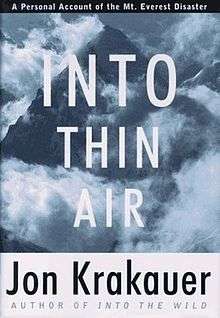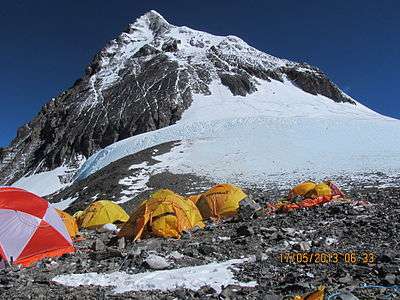Into Thin Air
 Hardcover edition | |
| Author | Jon Krakauer |
|---|---|
| Cover artist | Randy Rackliff |
| Country | United States |
| Language | English, Chinese, Japanese |
| Subject | 1996 Mount Everest disaster |
| Genre | Non-fiction |
| Publisher | Villard Books |
Publication date | 1997 |
| Pages | 416 pp. (Hardcover edition) |
| ISBN | 978-0385494786 |
| OCLC | 42967338 |
| Preceded by | Into the Wild |
| Followed by | Under the Banner of Heaven |
Into Thin Air: A Personal Account of the Mt. Everest Disaster is a 1997 bestselling non-fiction book written by Jon Krakauer.[1] It details the author's presence at Mount Everest during the 1996 Mount Everest disaster, when eight climbers were killed and several others were stranded by a "rogue storm". The author's expedition was led by the famed guide Rob Hall, and there were other groups trying to summit on the same day, including one led by Scott Fischer, whose guiding agency, Mountain Madness, was perceived as a competitor to Rob Hall's agency, Adventure Consultants.[2][3]
Summary
In the book, Jon Krakauer described the events leading up to his eventual decision to participate in an Everest expedition in May 1996, despite having mostly given up mountain climbing years before. The 1996 season expedition recorded 8 deaths, the third most on Everest in a single day (the April 2015 Nepal earthquake caused the most, at least 19 deaths), including Krakauer's guides Rob Hall and Andy Harris. Initially, Krakauer, a journalist for adventure magazine Outside, stated that his intentions to climb Everest were purely professional. The original magazine story was to have Krakauer climb only to base camp, and report on the commercialization of the mountain. However, the idea of Everest reawakened his childhood desire for climbing the mountain. Krakauer asked his editor to put off the story for a year so that he could train for a climb to the summit. From there, the book chronologically moves between events that take place on the mountain and the unfolding tragedy which takes place during the push to the summit. In the book, Krakauer alleges that essential safety methods adopted over the years by experienced guides on Everest are sometimes compromised by the competition between rival guiding agencies to get their clients to the summit.
Controversy
Krakauer's recounting of certain aspects of the ill-fated climb has generated considerable criticism, both from some of the climb's participants and from renowned mountaineers such as Galen Rowell. Much of the disputed material centers on Krakauer's accounting of the actions of Russian climber and guide Anatoli Boukreev. An experienced high-altitude climber and guide for Scott Fischer, Boukreev descended the summit prior to his clients, ostensibly out of concern for their safety and in preparation for potential rescue efforts. Boukreev later mounted repeated solo rescue efforts, saving several lives. In his book, Krakauer acknowledged Boukreev's heroism in saving two climbers' lives, but questions his judgment, his decision to descend before clients, not using supplementary oxygen, his choices of gear on the mountain, and his interaction with clients. Boukreev provides a rebuttal to these allegations in his book, The Climb.
Galen Rowell criticized Krakauer's account, citing numerous inconsistencies in his narrative while observing that Krakauer was sleeping in his tent while Boukreev was rescuing other climbers. Rowell argued that Boukreev's actions were nothing short of heroic, and his judgment prescient. "...he [Boukreev] foresaw problems with clients nearing camp, noted five other guides on the peak [Everest], and positioned himself to be rested and hydrated enough to respond to an emergency. His heroism was not a fluke."[4]
The account has also been criticized for not informing the reader that the team members were receiving accurate daily weather forecasts and knew about the storm in advance.[5]
In Krakauer's 1999 paperback edition of Into Thin Air, he addresses some of the criticism in a lengthy postscript.[6]
Adaptations
Films
A feature film titled Everest was made by Working Title Films and Universal Pictures with director Baltasar Kormákur and released in September 2015.[7] Jason Clarke, Josh Brolin, Jake Gyllenhaal, Emily Watson and Keira Knightley star in the film, with actor Michael Kelly portraying Krakauer.[8] It is not based on Krakauer's book.[9]
Television movie
The book was adapted into the TV movie Into Thin Air: Death on Everest (1997), starring Peter Horton as Scott Fischer and Christopher McDonald as Jon Krakauer. The book and the film both contain the same strong editorial viewpoint regarding the fundamental causes of the tragedy, although the film differs sharply from the book in details regarding responsibility.
See also
- List of people who died climbing Mount Everest
- After the Wind, a 2014 book by Lou Kasischke.
- The Climb, a 1997 book by Anatoli Boukreev.
References
- ↑ Krakauer, Jon (1999), Into Thin Air: A Personal Account of the Mt. Everest Disaster, New York: Anchor Books/Doubleday, ISBN 978-0-385-49478-6
- ↑ Scott, Alastair (1997), Fatal Attraction; a review of the book Into Thin Air, New York Times
- ↑ Viesturs, Ed (2006), The Everest Decade; Ed Viesturs on 1996, National Geographic
- ↑ Rowell, Galen (29 May 1997). "Climbing to Disaster". Wall Street Journal. ISSN 0099-9660. Retrieved 2015-09-06.
- ↑ Ratcliffe MBE, Graham (2011). A Day to Die For. UK: Mainstream Publishing. ISBN 9781845966386.
- ↑ Krakauer, Jon (1999). Into Thin Air. USA: Turtleback. ISBN 9780613663618.
- ↑ Hopewell, John (6 August 2013). "'2 Guns' Helmer Kormakur Set to Climb 'Everest'". variety.com. Retrieved 17 January 2014.
- ↑ nsharath009 (25 September 2015). "Everest (2015)". IMDb. Retrieved 15 September 2015.
- ↑ NICOLE SPERLING (18 September 2015). "Everest director Baltasar Kormákur clarifies film's source material". Retrieved 20 September 2015.
Further reading
- Anatoli Boukreev, G. Weston DeWalt (June 28, 1997). The Climb: Tragic Ambitions on Everest. St. Martin's Press. ISBN 9780312168148.
- This account critically analyzes the Adventure Consultants team and provides an alternative explanation for the events of those few days on Everest. Krakauer has rebutted the claims of this book in a postscript to the 1999 printing of Into Thin Air.
- Ratcliffe, Graham (2011). A Day to Die For. UK: Mainstream Publishing. ISBN 9781845966386.
- This book puts forward evidence that detailed weather forecasts were being received by several groups well in advance of their teams' summit attempts. These forecasts highlighted clearly the oncoming strong storm that struck the mountain on 10th/11th May causing the tragedy. While most of Ratcliffe's comments are directed towards the two expedition leaders for ignoring the forecasts and continuing on the summit attempts, thereby exposing clients to such high risk, he also makes clear that in his view, Krakauer and many others' description of the storm as "sudden and unexpected" is wholly inaccurate. Furthermore, Ratcliffe suggests that Krakauer, by not mentioning the forecasts, did not produce an accurate or adequately researched account.
- Gammelgard, Lene (2000). Climbing High: A Woman's Account of Surviving the Everest Tragedy. New York: Perennial. ISBN 978-0-330-39227-3.
- The first-hand experience of Lene Gammelgard, of Boukreev's expedition.
- Trueman, Mike (2015). The Storms: Adventure and Tragedy on Everest. UK: Baton Wicks Publications. ISBN 978-1898573944.
- Mike Trueman, a member of the 1996 International Polish South Pillar Team, was at Camp 2 as the 1996 Everest tragedy unfolded. He was asked to descend to Base Camp where he coordinated the rescue effort. His book published in May 2015 complements the story related in Into Thin Air.
- Weathers, Beck; Michaud, Stephen G. (2000). Left For Dead: My Journey Home from Everest. New York: Villard. ISBN 978-0-375-50404-4.
- A first-hand account of Hall's expedition.
- Dickinson, Matt (1997). The Death Zone: Climbing Everest Through the Killer Storm. Hutchinson. ISBN 978-0-09-180239-4.
- A first-hand account of the storm's impact on climbers on the mountain's other side, the North Ridge, where several climbers also died. (Later republished as: Dickinson, Matt (2000). The Other Side of Everest: Climbing the North Face Through the Killer Storm. New York: Crown. ISBN 978-0-8129-3159-4.).
- Kasischke, Lou (2014). After the Wind: 1996 Everest Tragedy, One Survivor's Story. Good Hart Publishing. ISBN 978-1940877006.
- The first-hand account of Lou Kasischke, of Rob Hall's expedition. Kasischke details the events surrounding the summit attempt as well as the decision that saved his life.
External links
- Into Thin Air -- the original article by Jon Krakauer published in Outside magazine in September 1996 (saved by Archive.org)
- Interview with Peter Horton on the TV Movie
- Into Thin Air: Death on Everest at the Internet Movie Database
- NPR interview with Jon Krakauer, May 1996
